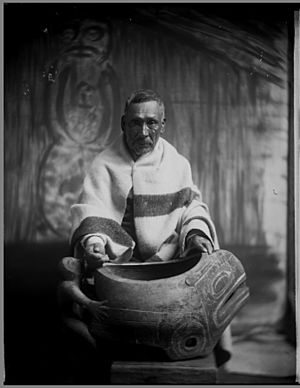Gwatʼsinux facts for kids
The Gwat'sinux (say "Gwat-see-nook") people, also known as the Quatsino, are an important part of the Kwakwaka'wakw peoples. The Kwakwaka'wakw are a large group of Indigenous peoples who have lived for a very long time on the coast of what is now British Columbia, Canada. The Gwat'sinux people are named after Quatsino Sound, a beautiful area on the northern part of Vancouver Island.
Contents
Who are the Gwat'sinux People?
The Gwat'sinux are one of the main groups that make up the larger Kwakwaka'wakw family. For thousands of years, Indigenous peoples like the Gwat'sinux have lived on the land, caring for it and developing rich cultures. They have their own unique history, traditions, and language, which is a dialect of the Kwak'wala language.
Where Do the Gwat'sinux Live?
The traditional territory of the Gwat'sinux people is located on the northern part of Vancouver Island in British Columbia, Canada. This area includes Quatsino Sound and the surrounding lands and waters. It's a place known for its beautiful forests, mountains, and ocean, which have always been central to the Gwat'sinux way of life.
Living on the Coast
Living by the ocean meant that the Gwat'sinux people were skilled at fishing and hunting marine animals. They also gathered plants and hunted animals from the forests. Their homes were often built from the strong cedar trees found in the region. The natural resources of their land provided everything they needed to thrive.
What is a First Nation?
In Canada, many Indigenous groups are officially recognized as "First Nations." This term is used to describe the many different Indigenous peoples who are not Inuit or Métis. The Gwat'sinux people are organized as the Quatsino First Nation.
How First Nations are Governed
A First Nation often has its own government, sometimes called a "band government." This government helps manage the community's affairs, including things like education, housing, and health. It works to represent the people and make decisions that benefit their community.
The Indian Act
The way First Nations are organized in Canada is partly due to a law called the Indian Act. This law was created by the Canadian government a long time ago. It has had a big impact on the lives of Indigenous peoples, including how their governments are set up and how their lands are managed. Today, many First Nations are working to have more control over their own affairs and to revive their traditional ways of governing.


